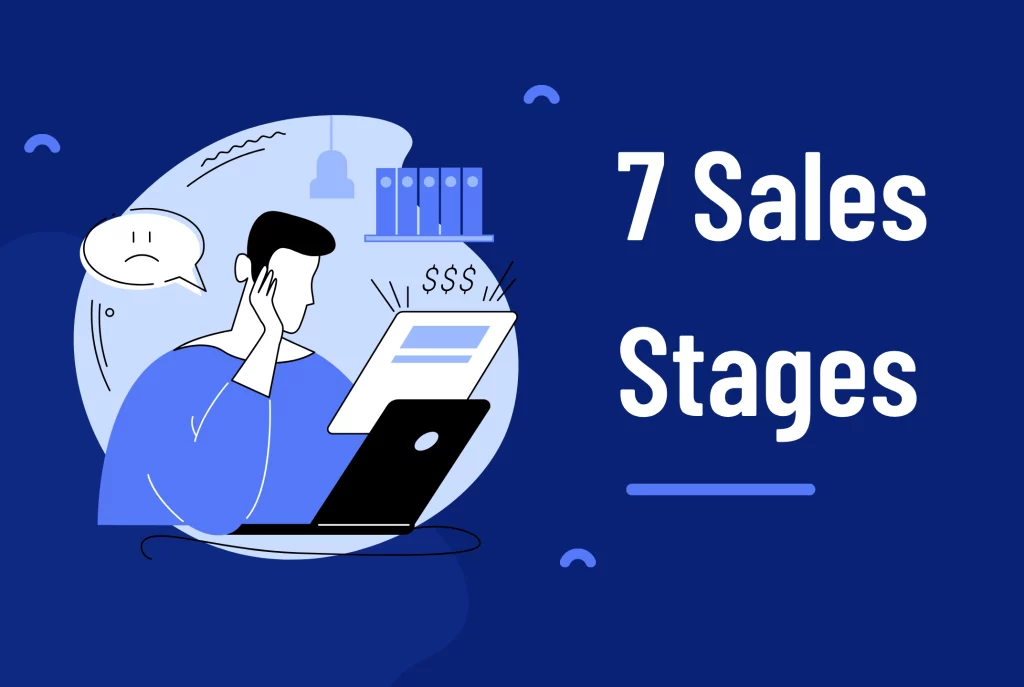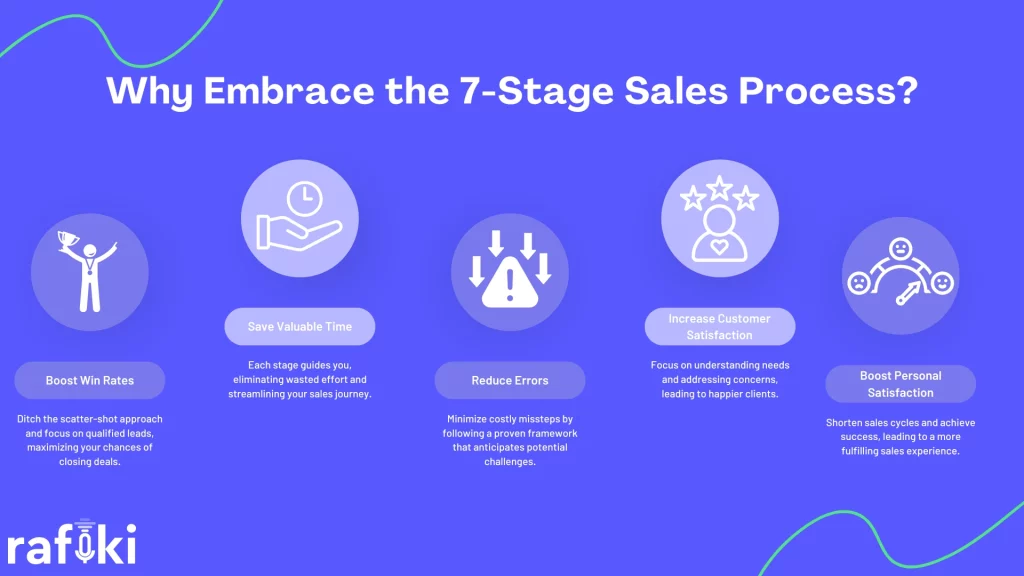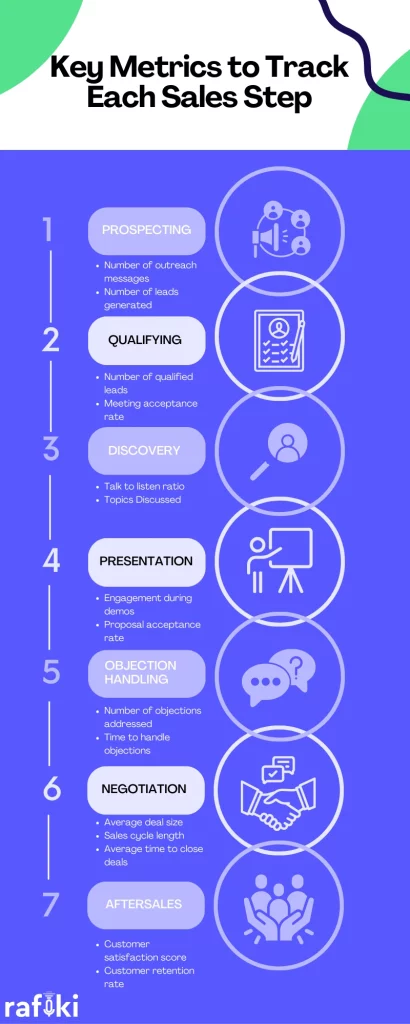Why Rafiki
Pricing


Pricing
Solutions

RevOps Leaders
Synchronize revenue generating functions

SDR Leaders
Get your team aligned and Coach your Reps 3x faster at scale

Sales Leaders
Unlock pipeline truth, drive confident forecasts

Feeling lost in the sales jungle? A structured approach is your compass. The 7 sales stages process is a roadmap to boosting sales and saving time.
Think of it like this: each stage helps you focus on the right activities, from finding potential customers to closing the deal. The result? More qualified leads, shorter sales cycles, and a happier you (and your boss!).
Let's break down these stages and see how they can turn you into a sales superstar.
The 7-stage sales process might seem complex at first glance, but fret not! Each sales stage has a clear objective and specific actions to help you move the deal forward. Before we go through the stages, let's first explore why the steps are even needed.

Now that we know the why, let's break down these sales stages into bite-sized pieces:
This is where you identify potential customers who are a good fit for your product or service. Think of it as casting a wide net to gather leads.
Here, you make contact with your prospects, assess their needs, and determine if they're a good fit to move forward. It's like sifting through the net, keeping only the promising leads.
Dive deep into your prospect's specific challenges and goals. This is where you become a detective, uncovering their pain points and how your solution can solve them.
Now's your chance to shine! Showcase your product or service, highlighting its value proposition and how it addresses the prospect's needs. Think of it as the grand finale where you convince them why your offering is the perfect fit.
It's natural for prospects to have concerns. This stage is about addressing those objections head-on and demonstrating how your solution overcomes them. Imagine it as navigating a maze of doubts, guiding your prospect towards the solution.
This is where you work together with the prospect to reach a mutually beneficial agreement and finalize the deal. It's like crossing the finish line, marking a successful sale.
Your job doesn't end with the sale. Providing excellent post-sale support ensures a smooth transition and fosters long-term customer relationships. Think of it as building a bridge, connecting you with your customer beyond the initial sale.
As you progress through these sales stages, leveraging tools like Rafiki's Smart Call Summary can be a game-changer. By automatically generating summaries with key takeaways from each call, you can save valuable time and ensure you're never missing crucial information.

Leverage social media, industry events, and referrals to identify potential customers who align with your ideal buyer profile. Utilize well-crafted email templates and clear call scripts to initiate contact and spark initial interest.
Ask insightful questions to understand the prospect's pain points, goals, and decision-making process. Actively listen to their responses and use Rafiki's Smart Follow Up to send personalized emails summarizing key points and next steps, saving you time and ensuring clarity. Use a suitable qualification methodology like BANT, CHAMP, MEDDIC etc. to structure your qualification process.
Conduct thorough research on the prospect's company, industry, and specific challenges. Tailor your approach to address their unique needs and showcase how your solution directly addresses their pain points.
Craft a compelling presentation that highlights the value proposition of your product or service and how it solves the prospect's specific problems. Use strong visuals and storytelling to engage your audience and leave a lasting impression.
Anticipate common objections and prepare clear, concise responses that address the prospect's concerns head-on. Focus on reframing objections as opportunities to demonstrate the value of your solution and its ability to overcome their challenges.
Collaborate with the prospect to find a mutually beneficial agreement. Be prepared to negotiate certain terms, but maintain your value proposition throughout the process. Utilize Rafiki's Smart Call Scoring to gain insights into your call effectiveness and identify areas for improvement in your negotiation skills.
Provide exceptional customer service and ensure a smooth onboarding experience. Maintain regular communication and address any questions or concerns promptly. This fosters long-term relationships and sets the stage for repeat business.
Even the most seasoned salespeople encounter obstacles throughout the sales process. Here are some common pitfalls to watch out for and strategies to overcome them:
Don't waste time pursuing unqualified leads. Set clear criteria and stick to them to ensure you're focusing your efforts on potential customers with a genuine interest and the ability to buy.
The sales process isn't a monologue. Actively listen to your prospect's concerns and tailor your approach to address their unique needs. Rafiki can tell you the exact talk to listen ratio for each call you make.
Overpromising and under delivering damages trust and jeopardizes the sale. Be honest and transparent about your product or service's capabilities, focusing on delivering genuine value.
Objections are opportunities to showcase your expertise and address the prospect's concerns. Prepare clear, concise responses that demonstrate how your solution directly addresses their specific needs.
Don't pressure the prospect into a premature decision. Allow them time to consider their options and build trust throughout the sales process.
The below is a simple, hypothetical case study to give you a glimpse of how the 7 sales stages could be put into action:
“Company XYZ overhauled their prospecting strategy, leveraging a combination of targeted social media campaigns and industry event participation to connect with potential customers aligning with their ideal buyer profile. During the connecting and qualifying stage, they utilized the BANT (Budget, Authority, Need, Timeline) methodology to assess suitability and sparked engagement through personalized outreach emails and informative content.
To discover the prospect's actual needs, Company XYZ conducted in-depth interviews and utilized customer relationship management (CRM) software to gather historical data and buying patterns. Their research also involved analyzing industry trends and competitor offerings.
During presentations, they focused on showcasing tangible benefits directly addressing the prospect's identified pain points. Tailored presentations were created for different buyer personas within the prospect's organization.
To effectively handle objections, Company XYZ trained their sales team to actively listen, reframe concerns as opportunities, and provide data-driven solutions demonstrating their product's value proposition. When closing the sale, they employed a collaborative approach, working with the prospect to find a mutually beneficial agreement and ironing out specific details like pricing and implementation timelines.
Finally, Company XYZ prioritized post-sales support by providing comprehensive training and ensuring consistent communication to address any questions or concerns. This proactive approach fostered long-term customer relationships and increased the likelihood of repeat business.”
The 7-stage sales process doesn't exist in a vacuum. Technology can be a powerful tool to streamline each stage and boost your overall sales effectiveness. Here's how:
While the core principles of the 7-stage process remain constant, it's crucial to remember it's not a one-size-fits-all approach. Here's how you can adapt the model to different contexts:
The 7-stage sales process isn't a rigid script; it's a flexible compass to boost wins. Embrace it to ditch guesswork, focus on the right leads, and close deals faster. Imagine shorter cycles, happier clients, and a more confident you.
Move prospects through each sales step effortlessly
Adapt the framework to your industry, product, and methodology. Track your progress with key metrics to guide your journey. Leverage technology like Rafiki to gain insights and optimize your strategy. Sign up for a free 14 day trial today!